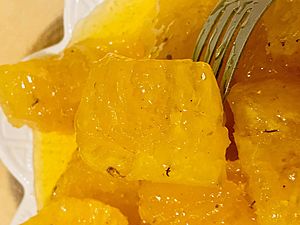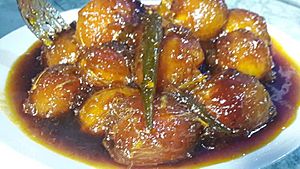Dosi (food) facts for kids

Annasi Dosi (Pineapple dosi)
|
|
| Type | sweetmeat or confectionery |
|---|---|
| Place of origin | Sri Lanka |
| Associated national cuisine | Sri Lanka |
| Main ingredients | fruit |
| Ingredients generally used | sugar, water |
| Variations | cardamom, cinnamon, rose essence |
Dosi (Sinhala: දෝසි, Tamil: தோசி) is a traditional sweet treat from Sri Lanka. It's a lot like candied fruit or fruit preserves. People make Dosi by cooking pieces of fruit in sugar syrup. As it cools, the sugar turns into tiny crystals all over and inside the fruit.
Dosi is often enjoyed as a snack during the day or after a meal. It's a very popular dish during special events like Eid al-Fitr celebrations, which mark the end of Ramadan for Sri Lankan Malays. You'll also find Dosi at weddings, religious festivals, and other fun gatherings. Sometimes, people add spices like cardamom or cinnamon, or even rose essence, to give it extra flavor.
Contents
What is Dosi?
Dosi is a type of sweet candy or confectionery. It's made by taking fresh fruit and turning it into a delicious, sugary snack. The process of making Dosi helps to keep the fruit fresh for a longer time.
How is Dosi Made?
Making Dosi involves a simple but clever cooking method. First, pieces of fruit are boiled in a mixture of sugar and water. This creates a thick, sweet syrup. As the fruit cools down, the sugar in the syrup begins to crystallize. This means the sugar forms tiny, solid crystals both on the outside and inside of the fruit pieces. This sugary coating gives Dosi its unique texture and sweet taste.
Different Kinds of Dosi
There are many different types of Dosi, each made from a different fruit or ingredient. The most well-known kind is puhul-dosi. This light yellow sweet is made from wintermelon, also known as ash pumpkin.
Here are some other popular types of Dosi:
- Inguru-dosi: Made from spicy ginger.
- Pol-dosi: Made from coconut.
- Annasi-dosi: Made from juicy pineapple.
- Ambarella-dosi: Made from ambarella (also called june plum).
- Amba-dosi: Made from sweet mango.
- Ala-dosi: Made from potatoes, which might sound surprising!
- Kiri-dosi: Made from milk, giving it a creamy texture.
- Apple dosi: Made from apples.
- Jambu-dosi: Made from java plum.
- Rambutan-dosi: Made from the fuzzy rambutan fruit.
- Banana-dosi: Also known as kesel-dosi, made from bananas.
Where Does the Name "Dosi" Come From?
The word "Dosi" comes from the Portuguese word doçe, which simply means 'sweet'. This Portuguese word itself comes from the Latin word dolce.
It's believed that this sweet treat was first brought to Sri Lanka by Portuguese sailors. They needed ways to keep food fresh during their long journeys across the sea. Boiling fruit in sugar syrup was a great way to preserve it. The sugar helps stop tiny living things (micro-organisms) from spoiling the fruit. It does this by drawing out the water from their cells, which makes it hard for them to survive.


